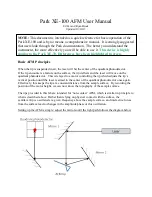
5-58
TMPM5200-2
■
e
it un
tilever becomes high; the cantilever
care
the cantilever might break. In
che
1.
eters
w
Cantilever automatic tuning (AC)
Specify the frequency and excitation voltage at which to vibrate the cantilever. If you us
der an ultra-high vacuum, the Q value of the can
amplitude becomes large even with a small excitation voltage. Therefore, if you
lessly apply a large excitation voltage to the cantilever,
the ultra-high vacuum AFM, use the instrument without checking the OSC High Output
ck box (
□
).
Click on the Cantilever button in the Advanced tab window (SPM Param
indow).
The Cantilever Tuning window will open.
.
Click on the AC/Phase tab of the Cantilever Tuning window; click on the
A
3.
C
place automatically as in the case of the AC AFC mode.
ection 1.4.1, “Adjusting a cantilever resonance point.”)
utomatic cantilever tuning. If, however, you have failed
■
Cantilever automatic tuning (FMD)
not only the Slope detection method
tection
a
comparativel
1.
ing window will open.
2
utotune radio button in the Tuning frame.
lick on the Scan button in the Tuning frame.
Cantilever tuning takes
(S
The procedure above completes a
to do so, you should also carry out the procedure for manual tuning.
In AC mode observation under ultra-high vacuum,
(RMS-DC) but also the FM detection method is applicable. Since the Q value of the
cantilever under a vacuum is high, positive feedback oscillation is possible. FM de
is well suited for flat samples with small observation areas, providing higher sensitivity
nd resolution than Slope detection. The disadvantage of FM detection is that stability is
y poor.
Click on the Cantilever button in the Advanced tab window (SPM Parameters
window).
The Cantilever Tun
















































